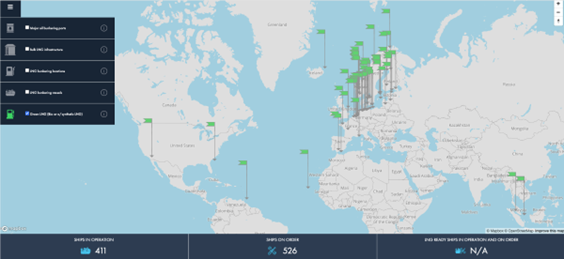
Close to 70 ports now supply green LNG

Screenshot of the SEA-LNG Bunker Navigator
(Source: SEA-LNG)
Bio-LNG, a green fuel produced from organic household and industrial waste, manure, and sewage sludge, is now available in almost 70 ports, according to the latest update from SEA-LNG in its online Bunker Navigator tool.
Northern Europe has the largest number of ports providing bio-LNG as fuel, but it is also available in major bunkering hubs on the US east coast, Rotterdam and Singapore.
Bio-LNG is produced from biomethane, of which about 30 million tonnes is produced each year, or about 10% of shipping’s total annual energy demand, SEA-LNG said. Since the fuel is produced from organic waste, it does not compete with the production of food, fibre, or fodder, as set out in regulations such as the EU’s RED II and the Renewable Fuel Standards in the United States.
There are currently some 355 ships, excluding LNG carriers, which can use bio-LNG as a drop-in fuel without modification. SEA-LNG estimates that the fuel can reduce greenhouse gas emissions by up to 80% compared with marine diesel on a well-to-wake basis and can be transported, stored, and bunkered using existing LNG infrastructure.
Last year, analysis by Singapore’s Nanyang Technological University’s Maritime Energy and Sustainable Development Centre of Excellence (MESD) concluded that there is huge potential to expand biomethane production, perhaps by 20 times current production levels by mid-century. Taking into account competition from other sectors, MESD forecast that bio-LNG could be available in sufficient quantities to decarbonise around 13% of the global fleet by 2050.
SEA-LNG’s general manager, Adi Aggarwal, commented on the latest Bunker Navigator update. “The fact that bio-LNG is commercially available now and being used as a drop-in marine fuel by operators in Europe, North America and Asia, demonstrates the sustained contribution that the LNG pathway can make to decarbonising our industry, starting today. Climate change is a stock and flow problem, the longer our industry waits to start using low-carbon fuels, the tougher the decarbonisation challenge will be.”
